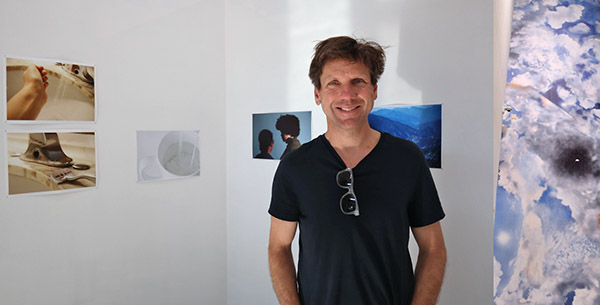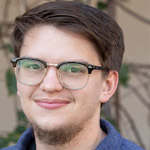“PROFile: Ken Fandell,” by Kyle Grace
April 21, 2020
Ken Fandell, HMC professor and incoming chair of the Department of Humanities, Social Sciences, and the Arts, shares his vision on art at the College and beyond. This story was first published by the HMC student-run newspaper The Muddraker.
Q: Introduce yourself to anyone who doesn’t know you and describe yourself to the community.
A: My name is Ken Fandell, professor of art, here at Harvey Mudd College. I’ve been here for eight years. It’s a funny question — my daughter, who’s seven, keeps asking me to come to her class and do one of these parents “what do I do” things. I tell her I will, but I was like, you know what I’m going to say: “I’m Christy Matson’s husband,” “I’m Lake Fandell’s father,” and then I’m going to say I’m an artist, then I’m going to say I’m a teacher. I’m also gonna say I go running a lot, and I go surfing a lot, because like I really feel each of those things is equally important in my life and that I don’t identify as any one of those things over the others. You know, I could identify myself as “I’m a professor of art here,” but I feel that’s shortchanging myself.
Q: Going along those lines, why did you choose to come to Mudd to teach art?
A: Because I’m crazy! No, because it’s awesome! I taught for 12 years at an art school, what I would argue is the best art school in the country, the School of the Art Institute of Chicago. I thought I was going to be teaching there forever. I was tenured, I was the chair of a department, I loved Chicago, and I loved my colleagues, I loved the students there, but then I saw this posting for this job here at Harvey Mudd College. It said, “seeking an artist, must be able to teach in one or more of the following fields,” and it listed every field. I was like, “who are these crazy people?” but it really lined up with how I thought about myself as an artist and with how I thought about myself as a person. I don’t do any one thing.
I was the chair of the photography program, but my own art was drawing, sculpture, performance, sound art, video art. I do all these different things, I have all these other interests, and this seemed like a position that might reflect my personality more than just being a photo professor, so I threw my hat in the ring for it. I came out here to interview, and by the end of the first day of the interview, I was like, “This place was incredible.” From the faculty, to the students, to the staff, I was like, “Wow.”
Q: How do you see art fitting in with the STEM-heavy curriculum that we have here at Mudd?
A: Well, this is one of my more controversial positions here: I feel that the STEM-heavy curriculum’s responsibility is to fit in with art. I don’t feel like I need to bend what I do to fit everyone. I think that people’s studies and STEM really relate to what they’re going to do with art. In engineering, you’re going to go out and make a hammer, and it would just take a slightly different point of view to think of that hammer as an art project. So I’m really glad engineering is teaching artistic practices to all my students. I [also] think the kind of abstract thinking that goes on in the math department is right up along the lines of the things I want students to be doing in our class. It’s awesome that all these things can feed into creative ideas and skills and curiosity that helps to make art.
Q: What would you say are the best parts of working with the students here, and then also the not so best parts?
A: When I taught at art school, I’d often get students showing up thinking, “I know what art is; this is what I want from this class; if you’re not giving me this, you’re not doing your job.” Mudd students show up, and they’re really open to whatever art can be. My second most favorite thing about working with my students is how hard they work. They put their all into everything that I asked them, and even if they don’t, they’re pretty good at convincing me that they did. One of the things I don’t think is helpful is how concerned they are with grades. I came from an institution where everything was pass/fail, and I think that is a better way to learn. A place like Mudd would actually really work well with pass/fail because everyone is so motivated. I don’t think it’s just the grades that motivate [them], and if we took that pressure off, I think deeper, true learning would happen.
Q: Since I know this is a question you ask in some of your classes, could you give your verbal manifesto of art?
A: One of the things to understand about my teaching is that I don’t ask students to do anything that I think is easy. Everything that I ask, I struggle with myself. It’s not about like, “Oh, this is something you have to learn to do, and I’ve perfected it.”
This idea of a manifesto of art is really, really tough, and I love studying it. So, I would have to sit down and craft it for a while. Off the top of my head, I think one of [the principles] is conviction. You’ve got to mean it; it’s nothing if you don’t do it with intensity and purpose.
I also think you have to take risks. It’s nothing if you just make a thing that you know is good. I think you need to take the chance to make the thing that sucks. It’s experimentation. I don’t think it should ever come out exactly like what you had in your head. If you’re sort of beholden to your original idea, you’re not doing your job as a maker of art, which is to move beyond whatever that idea was.
Q: Could you talk a little bit about how you see your role within the department is changing as you become department chair of HSA?
A: First thing I’m doing is this department will no longer be referred to as HSA. It’ll be referred to as arts, humanities, and social sciences. I’m going to forbid students from using the word “hum” — they’re not going to be taking “hums”; they will be taking “arts” classes. I’m going to be really strict about that, get everybody to sign off on it. No problem.
Q: To talk a little bit more about your projects as an artist, are you working on anything right now?
A: I sort of carved out a spot here at Mudd, where it seems like art projects are leaking into my classes. I teach that really big art class, and that’s an art project, setting up a situation where 125 undergrads, mostly STEM students, are doing performance art. I’m [also] teaching a class on color this semester. Every day I teach, I’m wearing a very colorful jumpsuit, and I think of that as an art project. Somebody over the weekend asked me what medium I’m working these days, and I said, “Uh, color jumpsuits?”
I have these small projects where I make these short little animations that wind up on Instagram. I make a lot of those, and they’re really quick and fast. They consist of either abstract drawings that I do or photographs, then sometimes those lead to bigger projects. There are these two little sheep skins that we got from IKEA, and I really liked how they look, so I brought them to the studio, and I’ve been shaping them into little sculptures and photographing them.
Q: Do you have some of your favorite projects you’ve done, just in general, that you want to highlight?
A: I have a big piece I just got installed at the Asheville Art Museum in Asheville, North Carolina. It’s huge. It’s like 40 feet tall, so I’m pretty excited about that.
I think since I’ve gotten here to Mudd, I’ve made the best work of my life. I think Mudd has really given me time and space and encouragement to make art and experiment. Which is weird — you’d think coming from art school you would get more of that, but I feel like Mudd has treated my art-making as research. They’ve given me the same respect that they would give a scientist, stuff to really push the boundaries of what I’ve done. It has been inspirational as a teacher too — I think during the seven years I’ve been here, I’ve done my best teaching.
Q: Finally, what are your hobbies outside of teaching and making art?
A: I guess I don’t even think of the word hobby, but I think that depending on what day you meet me, I might introduce myself as a professor, I might introduce myself as an artist, I might introduce myself as my daughter’s father, my wife’s husband, I might introduce myself as an athlete, just depending on when you meet me.
Q: Is there anything else you want to say?
A: Take any opportunity you can to make art. Art is this fun, exciting thing. It’s not this boring thing that happens in classrooms that you’re made to do. Think of everything you do as art.
The Muddraker is a student-run organization at Harvey Mudd College that publishes every semester.
Kyle Grace

Kyle Grace is the chief of photography at The Muddraker and a CS/econ major in the Class of 2021. Outside of school and The Muddraker, he loves going to concerts, watching basketball and hanging out with friends.